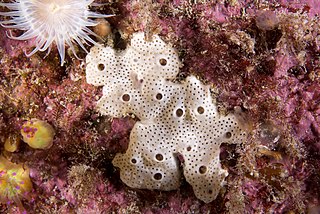
A tunicate is a marine invertebrate animal, a member of the subphylum Tunicata. It is part of the Chordata, a phylum which includes all animals with dorsal nerve cords and notochords. The subphylum was at one time called Urochordata, and the term urochordates is still sometimes used for these animals. They are the only chordates that have lost their myomeric segmentation, with the possible exception of the 'seriation of the gill slits'.

β-Carboline (9H-pyrido[3,4-b]indole), also known as norharmane, is a nitrogen containing heterocycle. It is also the prototype of a class of indole alkaloid compounds known as β-carbolines.

The Thaliacea comprise a class of marine animals within the subphylum Tunicata. Unlike their benthic relatives the ascidians, thaliaceans are free-floating (pelagic) for their entire lifespan. The group includes species with complex life cycles with both solitary and colonial forms.

Ascidiacea, commonly known as the ascidians, tunicates, and sea squirts, is a polyphyletic class in the subphylum Tunicata of sac-like marine invertebrate filter feeders. Ascidians are characterized by a tough outer "tunic" made of a polysaccharide.

Ciona intestinalis is an ascidian, a tunicate with very soft tunic. Its Latin name means, literally, "pillar of intestines", referring to the fact that its body is a soft, translucent column-like structure, resembling a mass of intestines sprouting from a rock. It is a globally distributed cosmopolitan species. Since Linnaeus described the species, Ciona intestinalis has been used as a model invertebrate chordate in developmental biology and genomics. Studies conducted between 2005 and 2010 have shown that there are at least two, possibly four, sister species. More recently it has been shown that one of these species has already been described as Ciona robusta. By anthropogenic means, the species has invaded various parts of the world and is known as an invasive species.

The Polycladida represents a highly diverse clade of free-living marine flatworms. They are known from the littoral to the sublittoral zone, and many species are common from coral reefs. Only a few species are found in freshwater habitats.

Didemnum is a genus of colonial tunicates in the family Didemnidae. It is the most speciose genus in the didemnid family. Species in this genus often have small calcareous spicules embedded in the tunic and form irregular or lobed colonies. Some Didemnum species, including Didemnum vexillum and Didemnum perlucidem are considered invasive species. In early 2006, Didemnum vexillum was found covering a 230 km2 area of cobble habitat in Georges Bank off the coast of New England, and is classified as an invasive species of greatest concern in coastal areas throughout Europe, New Zealand, and North America. Didemnum sp. invasions have also been recorded in Canada, the Mediterranean, and the Netherlands.

Botryllus schlosseri is a colonial ascidian tunicate. It is commonly known as the star tunicate, but it also has several other common names, including star ascidian and golden star tunicate. Colonies grow on slow-moving, submerged objects, plants, and animals in nearshore saltwater environments.

Botrylloides violaceus is a colonial ascidian. It is commonly known as the chain tunicate, but has also been called several other common names, including: lined colonial tunicate, orange sheath tunicate, orange tunicate, and violet tunicate. Its native range is in the northwest Pacific from southern China to Japan and Siberia. Colonies grow on solid substrates and consist of individuals arranged in twisting rows. Outside its native range, it is considered an invasive species and is becoming more common in coastal waters of North America and other waters around the world, likely being spread by shipping industries.

Canadian aquatic invasive species are all forms of life that traditionally has not been native to Canada's waterways. In Eastern Canada, non-native plant and animal species are a concern to biologists. Bringing non-native species such as invasive fishes into Canada can damage the environment and ecosystem by repressing native species due to food competition or preying. Invasive fishes enter the fresh waters of Canada in several ways including drifting, deliberate introduction, accidental release, experimental purposes and, most commonly, through the attachment on international boat hulls.

Patellamide A is a peptide natural product produced by Prochloron didemni, a cyanobacterial symbiont of Lissoclinum patella, and was first isolated in 1981. Patellamide A is one of many didemnid peptides. Other closely related peptides include patellamides B, C, and D and trunkamide. The patellamides and trunkamide show moderate cytotoxicity and activity against multidrug resistant cancer cell lines.
Prochloron is a genus of unicellular oxygenic photosynthetic prokaryotes commonly found as an extracellular symbiont on coral reefs, particularly in didemnid ascidians. Part of the phylum cyanobacteria, it was theorized that Prochloron is a predecessor of the photosynthetic components, chloroplasts, found in photosynthetic eukaryotic cells. However this theory is largely refuted by phylogenetic studies which indicate Prochloron is not on the same line of descent that lead to chloroplast-containing algae and land plants.
Cardiosporidium is a genus of parasitic alveolates in the phylum Apicomplexa. It infects the ascidian Ciona intestinalis.

Didemnum vexillum is a species of colonial tunicate in the family Didemnidae. It is commonly called sea vomit, marine vomit, pancake batter tunicate, or carpet sea squirt. It is thought to be native to Japan, but it has been reported as an invasive species in a number of places in Europe, North America and New Zealand. It is sometimes given the nickname "D. vex" because of the vexing way in which it dominates marine ecosystems when introduced into new locations, however the species epithet vexillum actually derives from the Latin word for flag, and the species was so named because of the way colonies' long tendrils appear to wave in the water like a flag.

Eudistomins are β-carboline derivatives, isolated from ascidians, like Ritterella sigillinoides, Lissoclinum fragile, or Pseudodistoma aureum.

Lissoclinum patella is a species of ascidian in the family Didemnidae.
Nephromyces is a genus of apicomplexans that are symbionts of the ascidian genus Molgula.

Lamellaria perspicua, commonly known as the transparent lamellaria, is a species of small, slug-like sea snail, a marine gastropod mollusc in the family Velutinidae. It is native to the northeastern Atlantic Ocean and the Mediterranean Sea, where it feeds on colonial ascidians.

Lissoclinum is a genus of tunicates.

Lissoclinum perforatum is a species of tunicate. The species was originally described by Alfred Mathieu Giard in 1872















